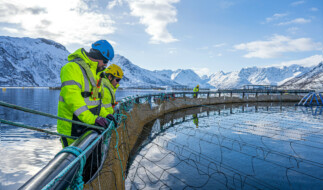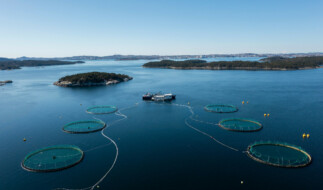Using collaboration to drive optimal fish health and welfare for farmed salmon
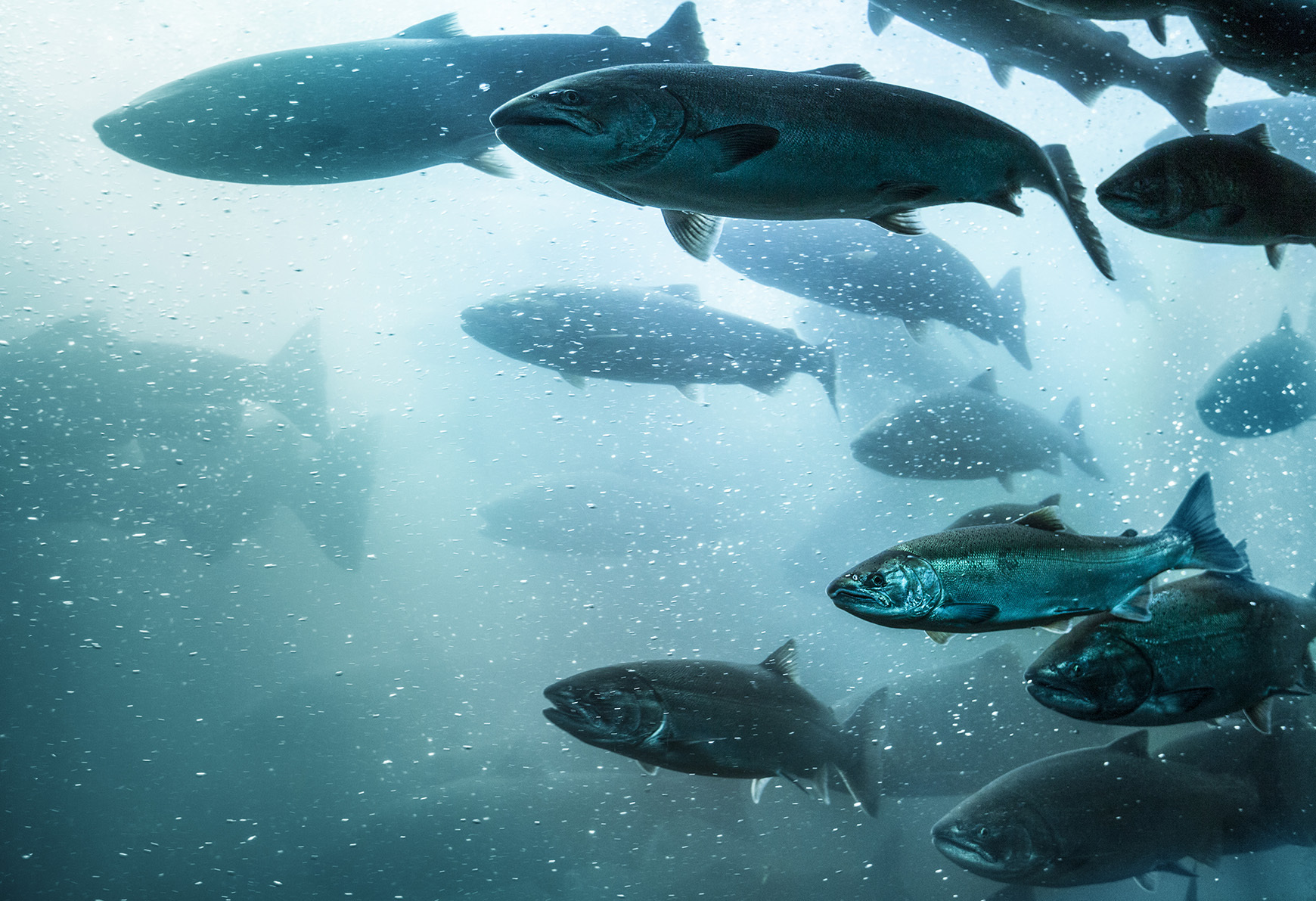
Ensuring optimal fish health and welfare is an integral part of each day for a fish farmer. Our role is to grow healthy, thriving fish, as those raised with high welfare perform better and ultimately have better quality. Good welfare is essential for the productivity and sustainability across our member farms, and as GSI our goal is to drive continued improvements in welfare practices through shared learning and best-practice sharing.
Our approach to optimal fish health and welfare
When GSI was established in 2013, biosecurity (i.e., disease management) was identified as one of the main challenges facing the global sector. The companies recognized that to ensure a more sustainable future for the sector, they needed to improve best practices in biosecurity management and ensure fish health and welfare was of the highest standard. For this reason, GSI immediately formed a dedicated fish health and welfare taskforce, the only one of its kind globally. The taskforce is made up of technical experts from each of the GSI member companies, alongside representatives from GSI’s Associate Members from the feed and pharmaceutical companies. The group saw this multi-sectoral connection being important to improve open dialogue between industry and supply to determine where innovations and improvements were needed and speed up the rate of industry improvements.
This unique taskforce acts as a global knowledge-sharing platform supporting GSI members in gaining access to multiple perspectives, and a deeper understanding of industry challenges and best practices in raising healthy salmon. The group focus their attention on key health and welfare best practices surrounding sea lice management, antibiotic reduction, gill health, welfare monitoring and supporting research into climate change adaptation and resiliency.
The taskforce meets virtually each month and holds an in-person 3-day workshop annually as an opportunity to come together to dive into the topics and learn from each other. Alongside the GSI attendance, the group often invites external experts, academics and innovators to discuss emerging research, technology or products which may support their mission of improved fish welfare.
What impact does this approach have?
By working together, uniting companies, suppliers, and experts from across the farming regions, we can facilitate faster and more scalable mutual learning and adoption of possible solutions. Rather than working in silo on shared challenges, companies can discuss what they are experiencing on the farms, how they are responding and if it’s working or not. Companies are able to discuss options and share experiences and knowledge all with the goal of improving awareness, understanding and best practices.
By opening the dialogues between industry and suppliers, we also support the industry in staying informed about new developments, and work with the developers to ensure new options are the most effective based on field experiences.
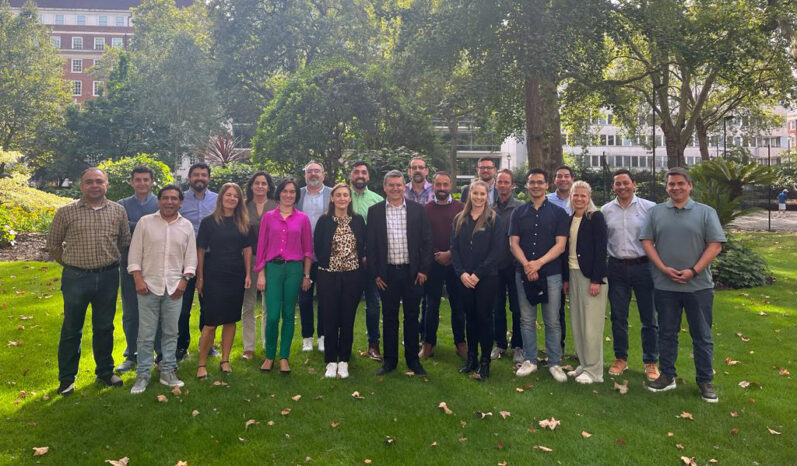
Members of GSI's Fish Health and Welfare Taskforce at this year's in-person meeting in London.
“The taskforce provides me with unique insights into salmon health worldwide, and how different organizations are understanding and adapting to challenges. Cermaq operates across three farming regions, but the GSI platform facilitates collaboration even more broadly so we can share experiences and learn from each other. We recognize as a sector there is continuous challenges to fish health and welfare and always ways we can improve so rather than work independently by sharing and learning from each other's experiences we have a better chance of adopting best practices and improving the sustainable performance of the sector globally.”Henrik Duesund, Cermaq Fish Health Manager
What are we working on to promote optimal fish health and welfare?
Ensuring optimal fish health and welfare for farmed salmon requires work on a number of approaches and continuous learning. Here are just a few examples of what the GSI taskforce is advancing with the support of our members.
Supporting Antibiotic Reduction
Just like people, salmon can get sick from various diseases. Sometimes, when there are no vaccines or preventive treatments, antibiotics are used to treat these diseases and bring the salmon back to normal health. Within GSI, our members are committed to only using antibiotics that are absolutely necessary and approved by authorized personnel.
Following significant progress in farming practices over the last decade, salmon farming currently uses the lowest levels of antibiotics compared to other animal farming sectors.[1] While this is a positive for salmon farming, we aim to reduce this further. Here are some ways the GSI taskforce supports this ongoing work:
- Continued exploration of alternatives to antibiotics like functional feed and probiotics to stimulate natural immunity to diseases
- Active engagement with pharmaceutical R&D to accelerate the development of new vaccines to prevent use of antibiotics for bacterial diseases
- Transparently reporting GSI member antibiotic usage in our annual sustainability report, allowing for benchmarks and monitoring over time
These efforts have proven successful, and since GSI’s founding in 2013, our members have achieved a 67% decrease in the average use of antibiotics in their farming operations.
Visit our blog here to find out more about GSI member's improvements in antibiotic reduction.
Sea Lice
Sea lice are a naturally occurring parasite found throughout the world’s oceans and on many species of fish. Controlling sea lice levels is a priority for GSI members, as fish are healthier and happier when sea lice are not present.
There are many approaches to managing sea lice, and companies are able to use both medicinal and non-medicinal treatments. The primary focus is always on ensuring minimal stress for the farmed salmon and maintaining a high standard of care.
GSI members are continually seeking new approaches and effective methods to reduce the number of sea lice, such as:
- Continually improving and evolving best practices to reduce the risk of sea lice
- Incorporating new technologies on the farms like physical barriers around the pens to prevent sea lice from entering
- Utilizing functional feeds to make the fish more resilient to sea lice
- Improved data collection and understanding on modelling water currents and predicting high-risk times and when to take action
- Incorporating “cleaner fish” in pens that naturally eat sea lice as part of their preferred diet
Managing sea lice has been a critical focus for the GSI members for over a decade now, and while progress has been made it seems sea lice are just as good as innovating as we are! So continued improvements are needed. Within GSI we are able to share developments on new strategies and what is working and save time repeating projects which others have found to be ineffective. One area which the group discussed at the 2023 taskforce meeting was the technical development of the sector to use post-smolt facilities to grow fish in RAS facilities for a longer time to reduce time at sea. This will reduce the risk of sea lice and reduce the need for medicinal treatments too. You can learn more on this emerging approach at GSI member Grieg’s website.
As part of GSI members' commitment to addressing sea lice, they report on sea lice counts and treatment usage in GSI's annual sustainability report.
Adapting to Climate Change
We know that the climate is changing, and increased temperatures are already having an effect on how and where we produce food. The ocean is like any other environment, and it's crucial to understand how salmon farming will be affected. We need to adapt because increasing sea temperatures, ocean acidification and shifts in freshwater ecosystems can seriously affect the survival and growth of salmon.[2]
“Salmon farming is a highly technical sector, with an abundance of highly specific environmental data. By working together and hopefully connecting their data and knowledge with our data and knowledge we can develop approaches to integrate climate models in coastal regions and farming practices to better understand the likely impacts of a changing climate and how the sector might adapt more successfully to ensure continued production of healthy and sustainable fish.”Lynne Falconer, University of Stirling
Given the scale of this challenge and the still uncertain consequences, the GSI platform is a useful opportunity to combine knowledge with experiences of evolving situations. Within our taskforce, companies are able to share how warming waters are impacting their operations and how it may impact fish welfare in the future. We believe that together we can build greater awareness and understanding, supporting the sector in being better positioned to make smart decisions.
GSI is also working with Stirling University and Nofima to support their research into aquaculture climate resiliency to help bridge the gap between research and private sector to support the development of industry specific climate models with an end goal to inform adaptation strategies.
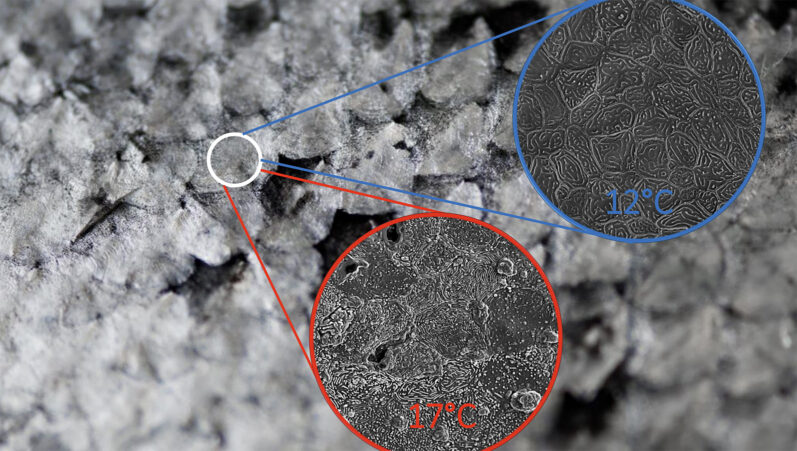
How the structure of fish’s skin changes between 12 and 17 degrees Celsius, from https://www.frontiersin.org/articles/10.3389/fmars.2023.1232580/full
Developing welfare metrics
There is no universal definition of optimal fish welfare, but we know that to fully ensure optimal welfare we need to have a standardized way of monitoring conditions. So, within GSI we are developing an internal program to align on how we monitor fish welfare, so we benchmark performance and learn from each other on best practices. We recognize there is a lot to learn here still, but by working together and uniting our expertise and knowledge we aim to drive improvements much faster than working alone.
Conclusion
Farmed salmon is one of the most frequently consumed seafood products around the world, and with that comes great responsibility to raise fish to the highest standards that ensure healthy fish, healthy people and a healthy planet. We have seen within GSI that by working collectively we can pool our knowledge and resources to strengthen our awareness and accelerate improvements to fish health and welfare. We recognize this is an area where continuous improvements are needed and new challenges may arise, but by working together we are confident we are better positioned to make effective and informed choices for the benefit of our salmon.
